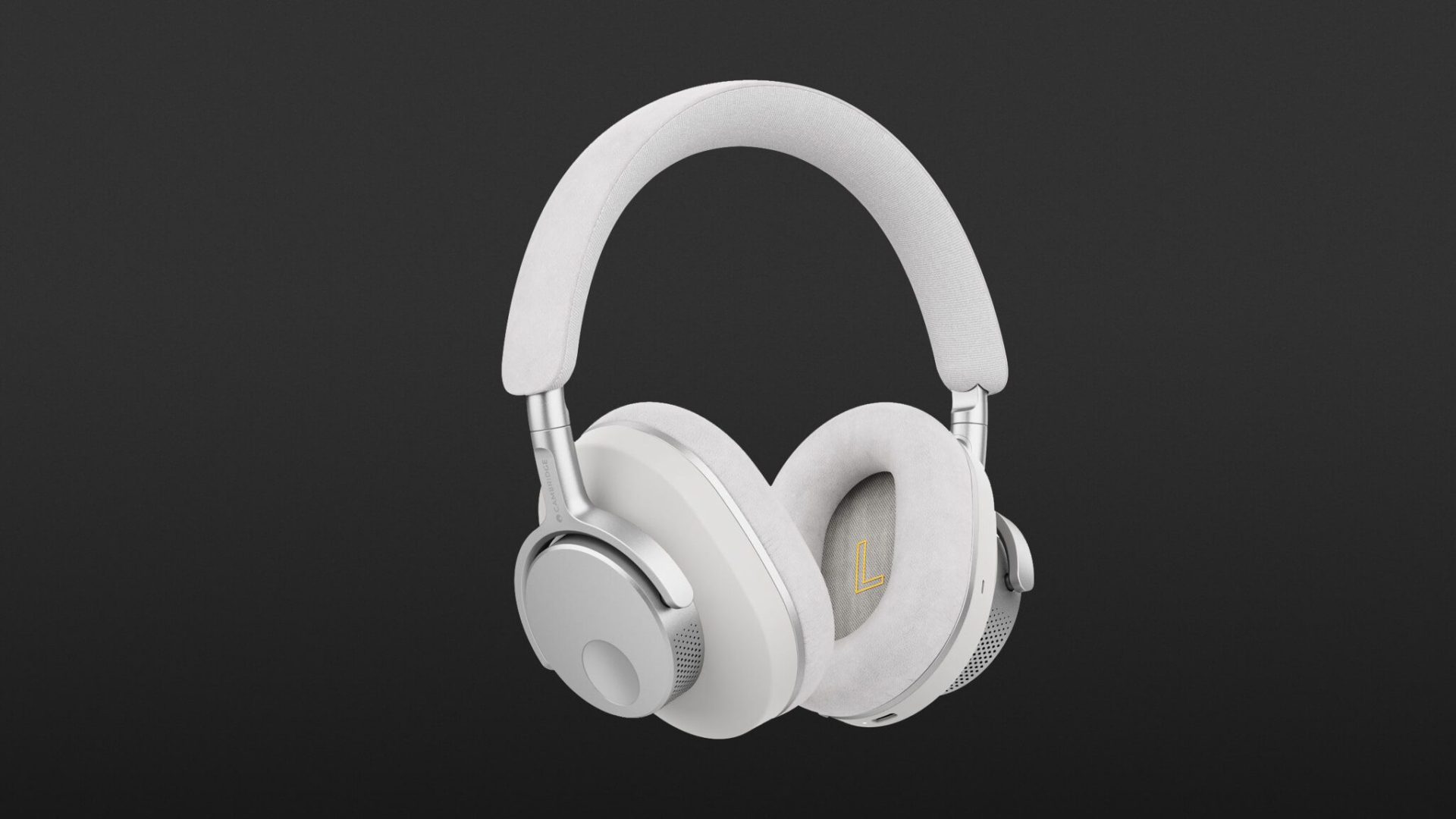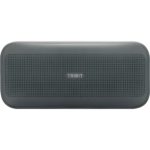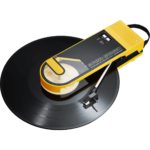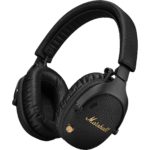Cambridge Audio has done many things right with its debut over-ear headphones for mobile Bluetooth use. The Melomania P100 delivers convincing sound quality, practical noise cancelling, straightforward controls, and excellent runtimes. With a current suggested retail price of 239 euros, it is a genuine alternative to the established providers on the market.
- Good to very good sound
- Noise cancelling
- Easy operation
- Very long battery life
Cambridge Audio from England was founded back in 1968 with the goal of developing and producing audiophile products. That hasn’t changed to this day. Today, the manufacturer’s product portfolio ranges from speakers to amplifiers and streaming devices, all the way to headphones.
The Melomania P100 is Cambridge Audio’s first wireless over-ear headphone, taking on the competition with noise cancelling, a long battery life, and, most notably, supposedly good sound.
Design and Scope of Delivery of the Cambridge Audio Melomania P100
On the outside, the Melomania P100 appears both high-quality and understated. According to the manufacturer, the construction is made of 50% recycled plastic and comes entirely in black or, alternatively, in a matte white finish. It has no decorative elements and is shipped with a carrying case. Only the brand’s typical circle appears as a recess on the outer sides of the earcups. The headband is padded and can be continuously adjusted in length. The earcups can be swiveled and rotated, feature memory foam padding, and are covered with leatherette.
The dynamic 40 mm compound drivers, made of a triple-layer composite (polyurethane and PEEK), have a fabric covering whose printed markings immediately show which side is left and which is right.
Other than that, the headphone relies on a simple operating concept via buttons on the device, aiming to make the free app largely unnecessary. With a current MSRP of 239 euros, the Melomania P100 is very attractively priced and competes with models from Sony, Bose, or Bowers & Wilkins.
The Cambridge Audio Melomania P100 in Practice
The headphones remain comfortable and relatively pressure-free on the head for extended wear. For mobile use, they are best suited for walks, though less so for athletic activities. In terms of functionality, they provide everything needed for mobile music enjoyment and communication even without the app. A toggle switch is used to turn the Melomania P100 on and off. Another button on the left side allows you to switch between transparency mode, playback without noise cancelling, and active ambient noise suppression. On the right earcup, there are three additional buttons. These control the volume and music playback, including track skipping. In addition, you can handle phone calls and call up a voice assistant on your smartphone.
Using the clear and free Melomania Connect app for iOS and Android, you can configure further functions. Besides firmware updates (current version: Firmware 0.1.48), you have access to a variable equalizer with several presets and the option to store your own configurations. There is also multipoint capability with two Bluetooth transmitters and an automatic shutdown in case of inactivity. You can also reduce the latency to 80 ms for gaming and watching videos.
Cambridge Audio Melomania P100: Up to 100 Hours of Battery Life
Cambridge Audio sets standards when it comes to battery performance, because when fully charged, it reaches a playback time of 60 to 100 hours depending on volume and whether noise cancelling is active. Without having verified these figures exactly, I can confirm that the Melomania P100 needed almost no recharging at the USB-C port over the course of the week, despite long walks and ongoing phone calls, and it handles lengthy train or plane trips without complaint.
It takes about 160 minutes to fully recharge, though a quick-charge feature also makes shorter sessions possible. Exemplary: both the built-in battery and the earpads can be replaced.
For phone calls, Cambridge Audio relies on multiple microphones and Qualcomm’s current Clear Voice Calling (cVc 8.0), which effectively suppresses background noise and focuses on speech. According to my conversation partners, call quality was good, though in some cases also slightly inconsistent.
Noise Cancelling
In mobile use, noise cancelling is certainly a plus and a selling point. The closed design of the Cambridge Audio Melomania P100 already provides good passive noise dampening. In three intensity levels, you can additionally activate noise cancelling or, conversely, a transparency mode. Depending on your needs, you can create a quiet space or enable environmental awareness and communication while keeping the headphones on.
The noise cancelling is effective and ensures a more immersive music experience. Even without music playing, you can better escape static ambient noise in places like trains or airplanes. The system works effectively, though less intensively than, for example, Sony’s solution in the WH-1000XM5 (see review).
How Good Does the Cambridge Audio Melomania P100 Sound?
Given how the manufacturer positions the Melomania P100, one naturally expects high sound quality. Beyond the driver itself, Cambridge Audio supports this with a Class A/B amplifier, which is typically not found in wireless designs. For wireless transmission, it uses Bluetooth 5.3, supporting the audio codecs SBC, AAC, and aptX Lossless, as well as aptX Adaptive. The latter allows resolutions of up to 96 kHz and 24 bits (not for Apple devices).
Nick Cave’s track “Galleon Ship” vividly demonstrates the deep bass capabilities of this design. Here, the eardrums vibrate, yet the voice is not overemphasized. In the next track, an orchestral recording of the Berlin Philharmonic under the direction of Herbert von Karajan, the headphones displayed their dynamic and spatial strengths. The musicians’ interaction results in a coherent sound body, while acoustic instruments retain a natural timbre. Due to the high level of detail, you can truly immerse yourself in the recording.
In pop music, too, I immediately enjoyed diving in with Daft Punk’s “Get Lucky,” where the balanced warm and nuanced mix is simply fun. The test candidate also handles aggressive genres like hard rock and metal with good results. The mixes, tailored to the genre, were reproduced consistently punchy and with taut definition, with the variously distorted guitars coming through clearly and without the headphones contributing any unwanted sharpness.
In summary, the Melomania P100 excels in its price range. I don’t see a pressing need for the seven-band equalizer in the app. Still, if you have specific preferences or want to correct hearing weaknesses, you’ll appreciate the added value.
I achieved particularly high listening pleasure, as expected, while seated in quiet environments. In these situations, I consider it an advantage to deactivate the noise cancelling, because otherwise you can hear a background hiss, and there’s also a kind of loudness effect. The latter is not necessarily a disadvantage for mobile use, though.
Additionally, the headphones can be operated via cable or USB-C. In both cases, they must be powered on. I used the Shanling DAP M3X (see review) as a source. When playing high-resolution material from Tidal, differences in sound quality between Bluetooth LDAC and wired operation weren’t particularly significant. Apparently, the well-tuned drivers do the heavy lifting. On the other hand, in a direct comparison with more expensive wired designs from the audiophile sector, the Melomania P100 can’t quite match their level of detail and transparency. But this device is primarily intended as an easy-to-use solution for mobile applications.
Conclusion
At a price under 250 euros, Cambridge Audio has succeeded with the Melomania P100, presenting a compelling entry into the premium over-ear headphone segment with noise cancelling. The relatively straightforward design focuses on high sound quality while not neglecting comfort features. The noise cancelling is practical, operation is simple, wearing comfort is good, and battery life is above average.
Technical specifications
- Ear couplingOver-ear
- Typeclosed
- Transducer principledynamic
- Weight without cable330 g
What's in the box
- USB-C to 3.5 mm cable
- USB-C to USB-C cable
- Carrying case
Special features
- Available in black and white
- BT version: 5.3
- BT codecs: SBC, AAC, aptX Lossless, aptX Adaptive














































